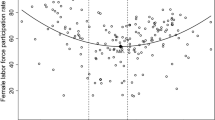Abstract
Alma Espino and Yvonne Underhill-Sem discuss the issue of regionalism and regionalization in Latin America and in the Pacific. Although there are important differences between these realities, they highlight advantages, dangers and challenges of economic integration for gender and social equity focusing on the power relations operating at various levels. They emphasize the need to improve knowledge about the gender dimension of these processes. Understanding the gendered implications of the geographic expansion of global capitalism will allow feminists to build proposals of economic integration schemes that are more comprehensive, gender-aware and oriented to human development.
Similar content being viewed by others
Notes
A greater structural heterogeneity thus extending the inequalities, which can be seen from the value recorded by the Gini index. This index records the lowest value (49.7) in the group of countries of moderate structural heterogeneity increases for intermediate structural heterogeneity (52.2) and in countries with severe structural heterogeneity reaches 53.3. This classification‐moderate, intermediate and sever structural heterogeneity – was made based on various indicators of economic performance, employment and structural heterogeneity: GDP per capita, GDP per worker, employment rate/population, composition of GDP and employment by strata productive productivity productive stratum (ECLAC, 2011).
The total exports in Mercosur were just over 20 percent in the peak intensity of the regional bond (1997 and 1998).
In the XXVI meeting that congregate gender authorities at the international level in Mercosur, was adopted a new name, from the Special Meeting to ‘Meeting of Ministers and High Authorities of Women’, as recorded in the Council Resolution Common Market – CMC – No. 24/02/11, allowing visible place gender authorities in the host countries.
In December 2010, the REM began to develop a regional survey for the conformation of comparable indicators on gender-based violence. These indicators should come from public services in the field of women's mechanisms, the system of justice, the police or the health system of each country.
It was established a Technical Committee on Gender, Labour and Economic Integration, and they are working on a plan to advance in this area.
The Plan contains lines, guidelines and priorities for the coordinated action of the States’ parties in the matter of social policy. It is considered an instrument able to articulate and develop specific actions to strengthen the social dimension of Mercosur. The most important issues are universal health, education, guarantees of access to decent work and welfare rights and it also emphasizes the need to promote distributive policies and ensuring the effective implementation of human rights in the region and appreciation of cultural diversity.
Cook Islands, Nuie and Tokelau.
Palau, FSM, Marshall Islands, Guam, Northern Marianas and American Samoa.
French Polynesia, New Caledonia and Wallis and Futuna.
Tuara Demke (2006, http://www.ffa.int/system/files/%252Fhome/ffaadmin/%252Ffiles/ffa/Gender%20issues%20in%20P.%20I.%20Tuna%20Industries%201.pdf). Also Slatter, Amberson-Bain, etc.
References
Amarante, Verónica and Alma Espino (2002) ‘La Evolución de la Segregación Laboral por Sexo en Uruguay (1986–1999)’, Revista de Economía 9 (1): 165–188.
Asafu-Adjaye, John and Renuka Mahadevan (2009) ‘Regional Trade Agreements Versus Global Trade Liberalization: Implications for a small island developing state’, The World Economy 32 (3): 509–529.
Atal, Juan Pablo, Hugo Ñopo and Natalia Winder (2009) ‘New Century, Old Disparities. Gender and Ethnic Gaps in Latin America’, IDB Working Paper Series (No. 109).
Bouzas, Roberto (2009) ‘Apuntes sobre el estado de la integración regional en América Latina’, Documento de trabajo N°1–2010, Noviembre 2009, UDESA-Argentina.
Di Filippo, Armando and Rolando Franco (2000) Integración regional, desarrollo y equidad, Siglo XXI – CEPAL.
ECLAC (2010) Time for Equality: Closing gaps, opening trails, May Santiago de Chile: ECLAC.
ECLAC (2011) Social Panorama of Latin America 2011, Santiago de Chile: ECLAC.
Hamilton, A., Lewis, A. and Campling, L. (2011) ‘Report on the Implementation of the derogation to the standard rules of origin granted to the Pacific ACP States in the framework of the Interim Economic Partnership Agreement’, Project implemented by LINPICO. European Union: Brussels, http://trade.ec.europa.eu/doclib/docs/2012/february/tradoc_149137.pdf, accessed 16 July 2012.
Hetzel, F.X. (2012) ‘Pacific Island Nations: How viable are their economies?’, Pacific Islands Policy No 7, Honolulu Easter West Centre, http://www.eastwestcenter.org/sites/default/files/private/pip007_0.pdf, accessed on 23 March 2012.
Kelsey, J. (2004) ‘Big Brothers Behaving Badly: The implications for the Pacific Islands of the Pacific Agreement on Closer Economic Relations (PACER)’, Pacific Network on Globalisation (PANG), PANG, Suva, http://www.arena.org.nz/bigbully.pdf.
Pacific Institute of Public Policy (2010) ‘Island Dreaming: A fresh look at Pacific regionalism’, Discussion Paper 15, Port Vila.
Randriamaro, Zo (2006) Género y comercio, Informe General Canasta Básica, UK: BRIDGE development and gender University of Sussex.
Red Mercosur de Investigaciones Económicas (RMIE) (2010) ‘América Latina en las cadenas globales de valor’, Policy Brief # 6 IDRC.
Slatter, Claire and Yvonne Underhill-Sem (2009) ‘Reclaiming Pacific Island Regionalism: Does neo-liberalism have to reign’, in Bina D’costa and Katrina Lee-koo (eds.) Gender and Global Politics in the Asia-Pacific, New York: Palgrave Mcmillan.
Terra, María Inés Terra and José Durán Lima (Coord.) (2010) ‘Impactos de la crisis en América Latina: ¿Hay margen para el diseño de políticas regionales?’, Serie Red Mercosur N° 18.
UNDP (United Nations Development Programme) (2011) ‘Regional Integration and Human Development: A pathway for Africa’, April 2011.
Vásconez, Alison (2011) ‘Mujeres, Hombres y las economías latinoamericanas: un análisis de dimensiones y políticas’, in Valeria Esquivel (coord.) La economía feminista desde América Latina: una hoja de ruta sobre los debates actuales en la región GEMLAC – ONU MUJERES.
Additional information
Presents two regional process and the implications for women's productive and reproductive work
Rights and permissions
About this article
Cite this article
Espino, A., Underhill-Sem, Y. Gender, Social Equity and Regional Economic Processes: Latin America and the Pacific perspectives. Development 55, 358–368 (2012). https://doi.org/10.1057/dev.2012.59
Published:
Issue Date:
DOI: https://doi.org/10.1057/dev.2012.59




